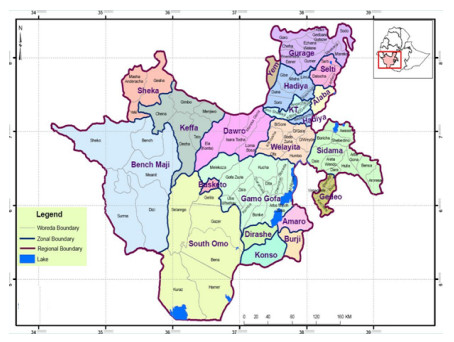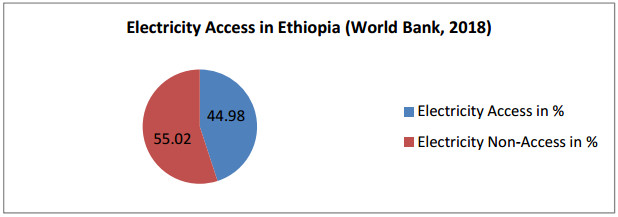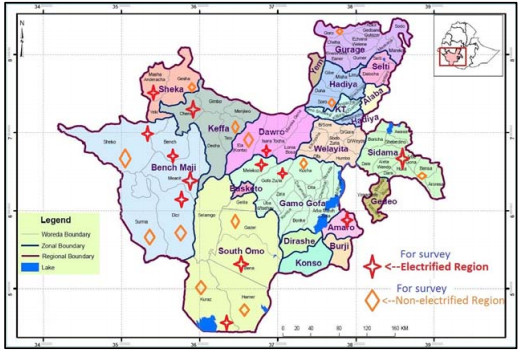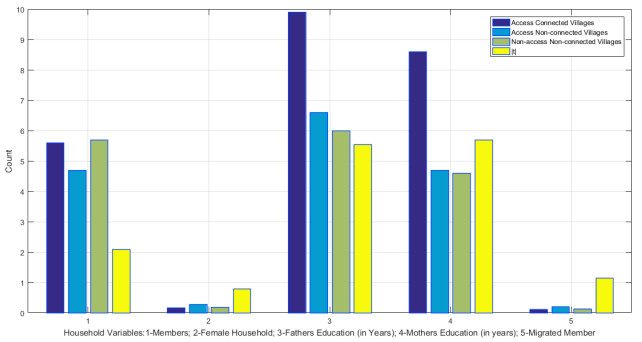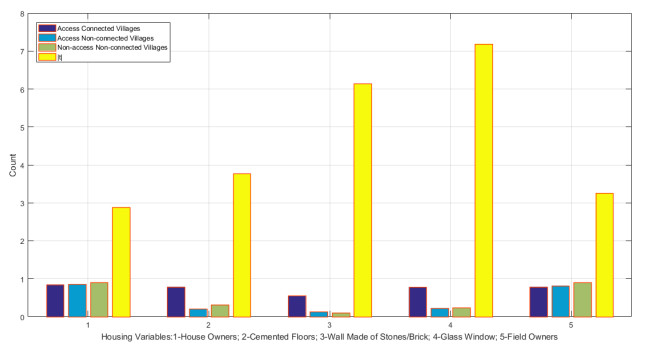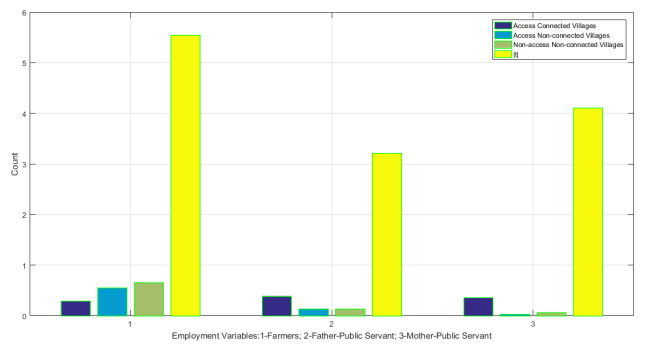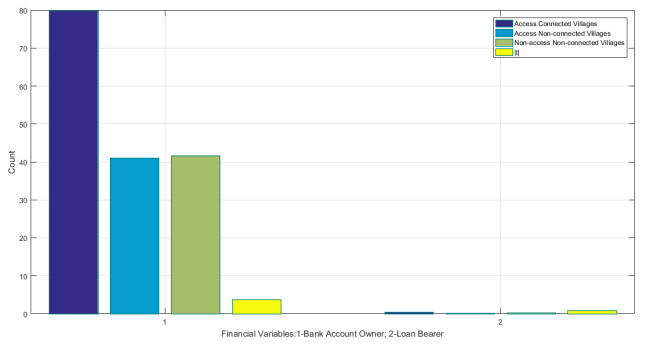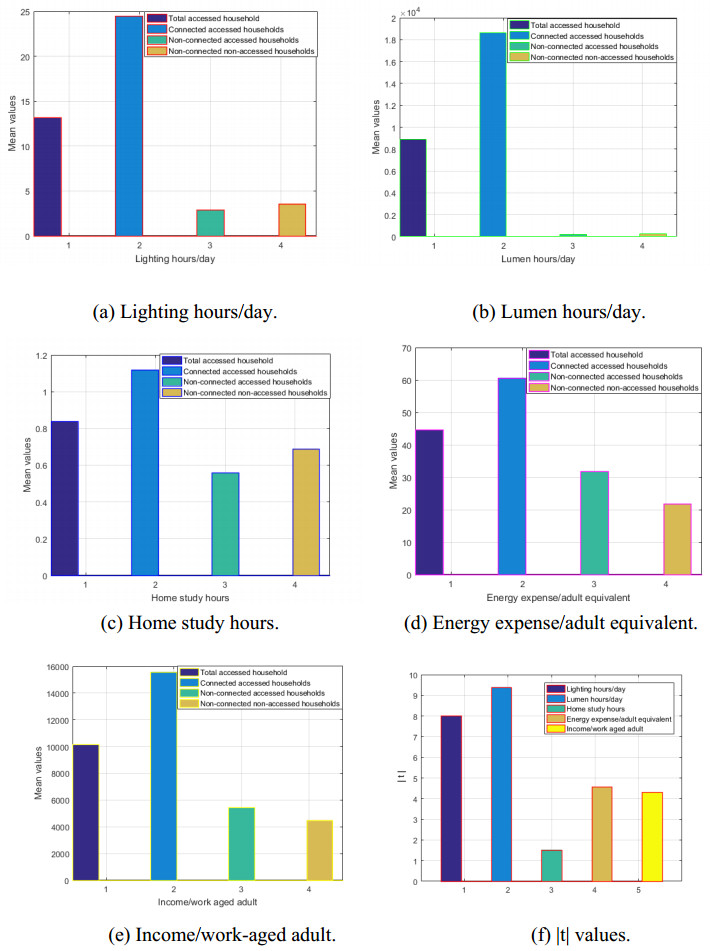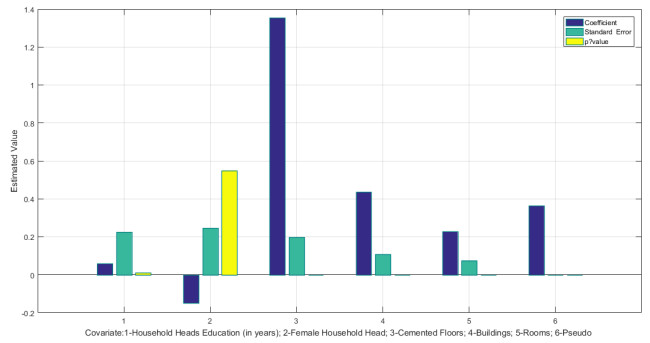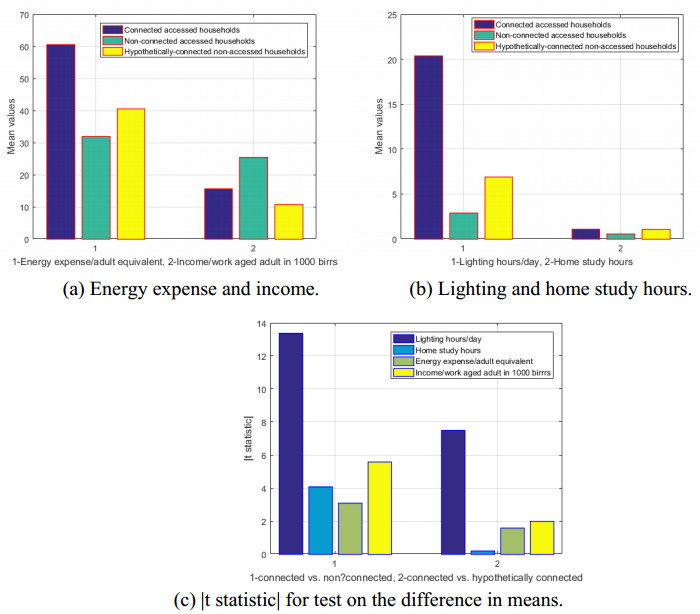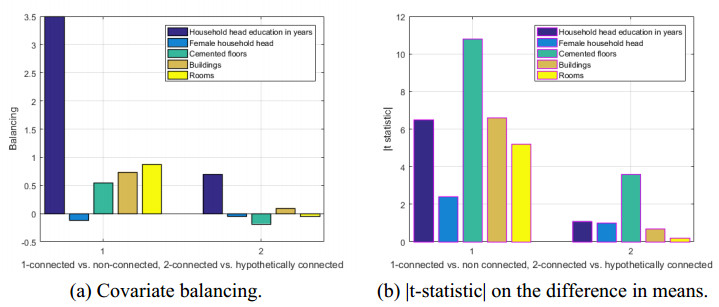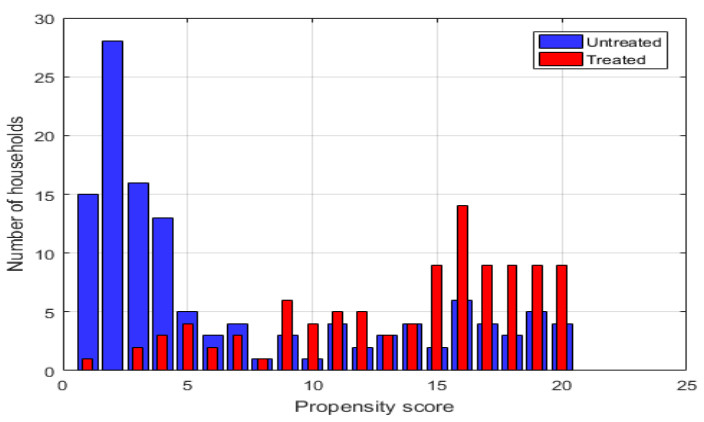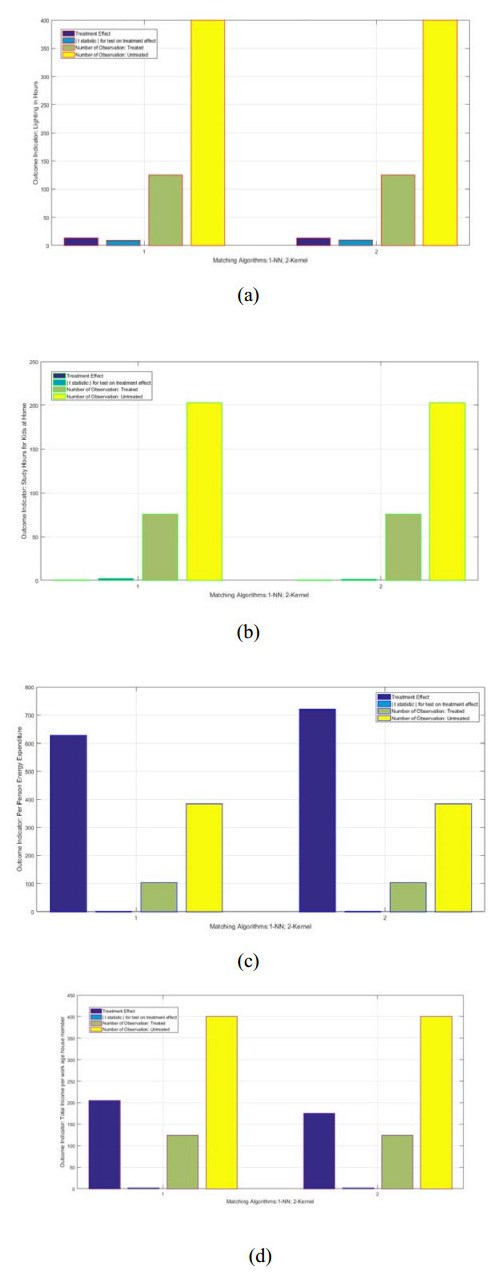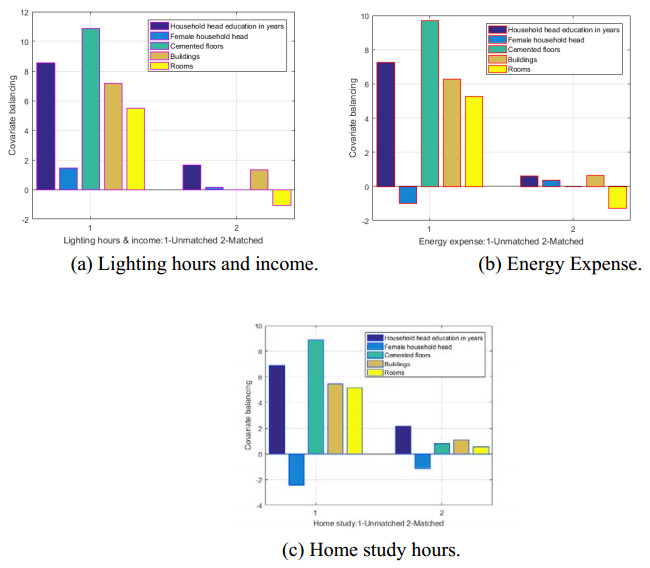The development of any country depends on the electrification of rural regions as most of the population is residing in rural areas. Development is counted in terms of per capita energy consumption as well as even distribution of electricity. This paper presents an investigation of the impact of rural electrification on lighting, studying, energy expenditure, and income. Data has been collected from southern region rural villages. Some villages are connected and some are non-connected with the grid. To estimate the decision probability of getting connected from households, electrified and non-electrified villages are evaluated. These observations are used to determine the impact of electrification of rural areas on resultant indicators. The authors observed a minor positive effect on home study and income, whereas a major effect on lighting usage. Finally, the potential improvements in the socio-economical status of rural people by improved lighting are highlighted.
1.
Introduction
According to the united nation development program organization, human development is an approach related to the expansion of the richness of human life rather than the richness of the economy [1]. The richness of human life can be brought by enhancing their education and living levels. For that purpose, sustainable development goals are required to fulfill. One of these goals is the seventh goal of the United Nations development program (UNDP), which recommends affordable, sustainable, and clean electricity for all. Electrification using sustainable and renewable energy sources has a significant impact on economic and social development, as well as on the improvement of the quality of life [2,3]. Electrification, in the African sub-Saharan countries, is still at low speed (less than 36%) regarding the population. The rate of electrification in rural areas of sub-Saharan countries is significantly lower than the other developing countries [4,5,6]. In most of the countries, electrification has been considered as the top priority to improve access and generation of electricity by using traditional as well as non-conventional energy sources [7]. In [8], Li et al. (2020) proposed the optimal design and techno-economic analysis of the hybrid energy generation system incorporated with solar, wind and biomass for the rural electrification of the off-grid area. In [9], Juanpera et al. (2020) developed a multi-criteria-based technique to design the rural electrification systems in Nigeria. In [10], Fatema and Ustun (2019) discussed the Lessons learned from rural electrification initiatives in developing countries. In [11], Cuesta et al. (2020) critically analyzed hybrid renewable energy modelling tools for small communities. In [12], Sato et al. (2017) discussed the challenges for the sustainable electrification respected to the Local tradition in Ciptagelar Village.
Ethiopia is situated at the horn of Africa. The political map of Ethiopia is shown in Figure 1
[13]. The government of Ethiopia is firmly determined to increase the production and availability of electricity for each citizen. Ethiopian government's sustainable development goals are similar to the UN, as the government is also working to provide affordable, sustainable, and clean energy to its citizens. Different international bodies (Bank of Arab for Economic Development in Africa (BADEA), World Bank (WB), the Kuwait Fund, African Development Bank (AFDB)) are providing funds for different projects of generation and electrification in Ethiopia. One such project is the Universal Electrification Access program (UEAP). It is initiated by the government of Ethiopia with the help of the World Bank and it's the largest electrification program that is run by the World Bank in Africa continent. The main aim of this program is to raise the access to electricity in all the regional states of Ethiopia and thus enhance the quality of living and reducing poverty.
In this context, in-depth and exhaustive study is required for finding the impact of rural electrification on the different levels of poverty. There are various pieces of evidence available for the poverty impacts on the Asian countries, but such empirical analysis is less available for the African countries [14]. Further, the findings of Asian countries cannot be applicable to the African countries due to geographical differences. It is required to have proper monitoring and analysis to evaluate the socio-economic impact of energy availability and the possibility of access to different socio-economic classes. For this purpose, the government and other bodies used to conduct surveys [15]. Various studies are performed for different regions such as [16] examined the impacts of getting electric connections on the time allocation of rural Guatemalans for the period of 2000–2011. In [17], Fujii et al. (2018) found the impacts of electrification on children's nutritional status in rural Bangladesh. In [18], Rathi and Vermaak (2018) estimated the impact of household electrification on the outcomes of the labor market for the individuals of India and South Africa. In [19], Thomas and Urpelainen (2018) examined the relationship between early electrification and electricity service quality to households. Further, the authors tested the hypothesis, which suggests that the aging of infrastructure deteriorates the quality of electricity supply. In [20], Malakar (2018) reinforced the energy services model proving that the evaluation of energy services should be done from a capability perspective instead of a utility perspective. In [21], Hartvigsson et al. (2018) compared the impacts of two capacity enhancement techniques, namely minimized cost strategy and diesel generator based capacity enhancement strategy on the long-term economic performance of rural mini-grid operator. In [22], Han and Wu (2018) examined the impact of the transition of residential energy on residential energy consumption per capita. Further, the authors identified various driving factors of transition in rural China. In [23], López-González et al. (2018) analyzed and compared the different cases of diesel generators technology such as off-grid; national grid extension connected and associated with distributed generation plants of rural zones in the context of Venezuela. In [24], Ding et al. (2018) estimated the impacts of electrification programs in rural China with the help of data-set, which is available for 2459 villages of China. In [25], Pueyo and De Martino, (2018) investigated the impacts of the provisions of electricity by solar mini-grids for improving the micro and small business in rural Kenya. In this paper, impressions of remote area electrification on social and economic indicators have been investigated for Ethiopia. For this purpose, household data of rural electrification project implemented in the Southern Nations, Nationalities, and People's Regional State (SNNPR), is utilized and analyzed. The location of the SNNPR region is presented in Figure 2 [26].
In the current study, the main aim is to assess the impact of electrification in rural areas by comparing the electrified and non-electrified household regions. Parameters of the study are based on children's study time at home, lighting usage, income and energy expenditures as well as other related opportunities (e.g., opportunities for youth, etc.). The analysis is performed on electrified and non-electrified houses in already grid-connected villages for estimating a probit model with the status of the connection of homes that conceded as a dependent variable. The probit model is used for predicting the probabilities to connect the sample houses those included in non-electrified villages. These probabilities and comparison techniques are used to analyze the effect of electrification by using different algorithms [5,27,28]. Houses, which are to be electrified or not to be electrified, are arranged in a straight line to simplify the study. The above-mentioned arrangement of houses is referred to as hypothetically connected houses. The hypothetically connected houses are compared to the actually connected houses in the electrified villages. Further, the results have been verified by using classical matching approaches. Approaches such as the nearest neighbor (NN) and Kernel matching algorithm are utilized for that purpose. These approaches are utilized by various researchers for matching the impacts on indicators of a particular problem. In [29], Miao et al. (2015) proposed a novel ensemble algorithm for Kernel Mean Matching method that splits samples into smaller parts. It predicts a density ratio for each part and after that merges these predictions with a weighted sum. In [30], Austin (2014) presented a detailed comparison of twelve algorithms of matching on the propensity score. In [31], Vestner et al. (2017) presented a methodology for matching 3D shapes under topology changes, non-isometric deformations and partiality. In [32], Taneja et al. (2014) reviewed enhancement, which is made in K-nearest neighbor algorithm. Further, an enhanced algorithm is proposed, which combines of dynamic selected and differently weighted schemes such as attribute and distance. In [33], Chen (2018) proposed the methodology of sample optimization, which is based on the CURE algorithm. Further, based on this method, a quick K-nearest neighbor algorithm is developed by the authors for finding the nearest samples. In [34], Jamma et al. (2017) developed and compared various hardware accelerators for the K-Nearest Neighbor classification method.
Ethiopia has an economy based on electric production by selling electricity to neighbouring countries such as Kenya, Sudan etc. The urban areas are developing fast due to different factors, out of which the major factor is proper electrification, while remote areas suffer due to non-connectivity to the grid. There are limited numbers of studies available for Ethiopia to show the socio-economic impacts of rural electrification.
The social and economic impacts of rural electrification on the SNNPR region are analyzed in this work. For that purpose, different social and economic indicators such as lighting utilization hours, home study hours of primary school students, income per house member and per person energy expenditure are considered.
The rest of the paper is organized as follows. Section two presents the current situation of electricity production in Ethiopia. The potential electrification impacts are described in section three. In the fourth Section, an analysis of the impact is performed by using propensity score matching algorithms. Section five concludes the study.
2.
Ethiopian energy scenario
In the northeastern part of Africa, Ethiopia is the country located in the horn of Africa. The current population of Ethiopia is more than 130 million, i.e., with respect to the area; the population density of Ethiopia is one of the highest in the continent. It is the country, where the major population is residing in rural areas and involved in subsistence farming and other agriculture-based works. Ethiopia is rich in natural resources and its main export items are coffee, livestock products (i.e., leather, live animals and meat), oilseeds, pulses, fruits, flowers, natural gum, spices, textile and mineral products, etc. Ethiopia has a substantial growth rate of 8–11%. Ethiopia is one of the fastest growing economies in the African continent and capable of stabilizing and rehabilitating the economy of the country. The Ethiopian government has focused on the development of the country by using various policy frameworks, which are based on good governance and leap forging. Significant progress is registered in the area of education, gender equality and health in Ethiopia. The main achievements of the Ethiopian government are in the field of aid coordination, infrastructure development, and harmonization. Like other sub-Saharan countries, Ethiopia lacks in electricity production and equal energy access. Urban populations have major access to electricity, even though the large populations residing in rural areas and have less access to electricity. The electricity access in Ethiopia, according to the World Bank [7], is 44.98% in the year 2018.
Figure 3 presents the electrification access in Ethiopia. Electricity consumption in Ethiopia is low and mainly consumed by main cities. In the initial days, the country had low power production e.g., before 1992, less than 4 hydropower plants have existed with insufficient capacities. Additionally, the geographical location (i.e., hilly and landlocked) makes it difficult and expensive to supply the electricity. The Ethiopian government is focused to tackle the persistent problem of poor energy supply in rural areas and to increase the access to grid electricity. Consequently, numbers of efforts have been made for the cooperation of international communities. From 1998, the rural electricity access program is continually financed by the government of Ethiopia in association with BADEA, WB, KF, and AFDB. The objective of this program is to achieve national electrification up to 90% till 2030. Apart from traditional power generation, the latest non-conventional energy generation units (PV, wind, Geo-thermal, etc.) are also constructed and commissioned. Various projects are initiated by the government for the enhancement of electricity production in Ethiopia [35]. For example, Adama I wind power project has an installed generation capacity of 51 MW. The total installed capacity of 153 MW Adama II wind power plant will be able to supply 480,000,000 kWh per year. Similarly, Ashegoda wind farm supplies 120 MW of electricity for more than 3 million Ethiopians. In the same way, various hydroelectric power plants also supplying electricity to the main grid. As Gilgel Gibe I dam is a rock-filled embankment dam with an installed capacity of 183 MW on the Gilgel Gibe River in Ethiopia. The Gibe II hydropower project is the second of the three plants constructed in the cascade manner. It has 420 MW installed capacity, which produced 1650 GWh energy annually. Further, Gilgel Gibe III hydropower plant has1870 MW total installed capacity. Beles hydroelectric power plant is a run-of-river hydroelectric power plant. The plant has an installed capacity of 460 MW. Further, the Tekeze hydropower plant has a total generating capacity of 300 MW. The Grand Renaissance dam is first designed to generate 6000 MW. Therefore, by all of these electricity generation plants, the Ethiopian government is planning to enhance the electricity access, because for eliminating poverty, electricity access is also the main factor. To eliminate poverty, the Government of Ethiopia has an integral and strategic plan to further increase access to electricity. Thus, in the first Sustainable Development and Poverty Reduction Program (SDPRP) started in 2002–03, the government of Ethiopia focused largely on growing access of electricity to motivate economic improvement. Further, the Plan Accelerated and Sustainable Development to End Poverty (PASDEP) project are also initiated to end the poverty. The objective of PASDEP is to improve the access to electricity up to 50% (around 24 million accompanying populations), by supplying 6000 rural villages and town, but UEAP project is already achieved 41% of electricity access at the end of the program year. Government's new commitments in relation to improve access of electricity are outlined in its Growth and Transformation Plan (GTP). Through the UEAP and GTP intend to increase the access of electricity up to 75%, which enable an additional 24.4 million people to get access to electricity.
3.
Research methodology, problem formulation and data analysis
3.1. Methodology
The following key comparability criteria have been selected for surveying:
● Geographic location and distance from the Hawassa city
● The agricultural structure of rural areas
● The economy based on cash crop
● The assessability of local and regional markets with respect to distance and count of visits, and access to standard roads
Figure 4 presents the project location and control site. The criteria for selecting electrified villages are that they should have grid connectivity for the last six years. In addition to the above criteria, the energy provider should provide unlimited power availability without any limitation to the use of electric appliances and machines. At last, all sort of electricity billing will be on metered data. Around thirteen sites were surveyed in selected zones from each category, each site comprising approximately two to thirteen agglomerations within a focused area. Some of the households from sites don't satisfy the surveying criteria; therefore, they were excluded from the analysis. Overall 43 houses from the mentioned sites were surveyed by using well-structured questionnaires. The supplementary qualitative data is also collected from local administration and professionals from various institutions and other related persons. The following sites are considered from the electrified region:
a. Zone Sheka, Woreda Masha Anderacha
b. Zone Bench Maji, Woreda Sheko
c. Zone Bench Maji, Woreda Bench
d. Zone Bench Maji, Woreda Meanit
e. Zone Bench Maji, Woreda Dizi
f. Zone Keffa, Woreda Chena
g. Zone Dawro, Woreda Isara Tocha
h. Zone Sidama, Woreda Hulla
i. Zone Gamo Gofa, Woreda Melekoza
j. Zone Gamo Gofa, Woreda Gofa Zuria
k. Zone Amaro, Woreda Amaro
l. Zone South Omo, Woreda Bena
m. Zone South Omo, Woreda Kuraz
The following sites are considered from the non-electrified region:
a. Zone Sheka, Woreda Gesha
b. Zone Bench Maji, Woreda Dizi
c. Zone Bench Maji, Woreda Sheko
d. Zone Bench Maji, Woreda Surma
e. Zone Keffa, Woreda Telo
f. Zone Dawro, Woreda Isara Ela
g. Zone Gurage, Woreda Gora
h. Zone Hadiya, Woreda Soro
i. Zone Sidama, Woreda Bensa
j. Zone Gamo Gofa, Woreda Kucha
k. Zone South Omo, Woreda Kuraz
l. Zone South Omo, Woreda Hamer
m. Zone South Omo, Woreda Gazer
3.2. Socio-economic characteristics of selected SNNPR areas
This section presents the information regarding the composition and socio-economic structure of the households, on the basis of the survey, which is given in Figures 5 to 8. The sites and projects are selected from the densely populated southern Ethiopia, having analogous geological and climate characteristics (e.g., rainfall and landscape). In rural areas, the houses are dispersed on hilly territory due to their traditions, which is the main reason for low incidents of migration. Few numbers of surveyed households have been migrated, that becomes the potency for the particular result.
In this section, the groups of households living in the villages are categorized on the basis of electrified (access) and non-electrified (non-accessed) villagers. The decision related to the connection of the grid is made at a household level. In Figures 5 to 8, houses are categorized as access and non-access household, whereas in access households, the connected and non-connected subdivisions are also depicted [36].
● Hypothesis Test: Difference between Means
● The two-sample t-test is best suited if the following circumstances are satisfied:
● The simple random sampling
● The independent samples
● The sampling distribution is approximately normal
Figures 5 to 8 describe the use of comparable characteristics at village level as well as comparable characteristic at a household level. Due to certain differences among characteristics of electrified and non-electrified sites, they are not comparable. After proper observation 26 electrified villages and 17 non-electrified villages are considered for the survey. To evaluate the actual difference, the heterogeneity between connected and non-connected household are also taken into account. For comparing electrified and non electrified villages, connected households are considered as a driving factor. The difference among the villages may be due to the selection process and electrification intervention but the impact yet not visible. This impact is computed in the assessment section. The connected households are using their connections for an average of 6 years, with a median of 3.5 years.
The lighting load is the main part of the domestic loading i.e. people are using electricity mainly for lighting purpose [37]. From past days, people are using kerosene lamps and hurricane lanterns. Candles are used as backup lighting sources in electrified houses. People seldom use torches, as they don't leave their houses after sunset. Normally, grid-connected houses use fluorescent tubes, incandescent light bulbs, and fluorescent light bulbs. Multiple room houses use on an average 1 to 2 bulbs. The Ethiopian government is strongly motivating and supporting the use of energy saving bulbs. A very few households are using electricity for commercial propose i.e., milling, sewing, and welding. In the electrified region, only eleven households having the sewing machine and most of them are mechanically energized. Moreover, in the electrified region, most of the houses have mobiles and radios, whereas less percent using television. Every second house uses electrical appliances apart from radio, mobile, and lighting. In non-electrified villages, hardly any appliances are used. Survey has two basic goals: first, to supply the basic data that is used for evaluation of impact; second, assessment of the expected impact of electrification (of access to the existing grid (after energized)) before the implementation of the project. For the survey, both types of regions are considered: first, the household in the non-electrified regions; second, households in the comparable project's electrified regions.
4.
Estimation of impact
4.1. Indicators and questionnaire for research
The conceptual framework is based on electrification interventions. Recent rural electrification (only in the certain percentage of houses) contributes to poverty reduction via different means. Non-electrified houses are also benefited by indirect advantages such as improved social services [38]. Four indicators are examined to identify the impact on the directly connected households:
● Lighting hours
● Lighting hours for home study
● Per person energy expenditure
● Income per house member
Lighting hour is considered as one of the main factor because low-cost access to high-quality lighting, affect life in the rural areas and make potential long-term socio-economical changes [39,40]. Some intermediate indicators are used in the calculation of lighting usages. Lighting hours are calculated by adding the units of light utilized per day overall lighting appliances. The second factor considers the education impact, i.e., home studying time of primary school children and youths only because secondary education is usually provided in boarding schools. In the third factor, the monetary effect due to the usage of electricity is accounted. The use of electrical appliances such as television or refrigerator increases the economic burden on households. There are different houses with different count of household; therefore, energy expenditure is normalized by dividing it into number of 'adult equivalents' in the household. The fourth indicator provides information related to the increased productivity with respect to electricity usage. In this case, the indicator is normalized by dividing the total income with the number of working-age adults in the household. Figure 9 presents the description of all the above mention indicators. These villages are having similar social and demographic characteristics that are mentioned in the previous section. To compare electrified and non-electrified villages, connected households are considered as a driving factor.
4.2. Impact assessment
To evaluate the impact of electrification, two principle strategies considered those are as follows:
● Before and after electrification, the comparison of household indicators
● Comparing households in the electrified non-project villages (access region) to non-electrified project villages (non-access region)
For the first principle, the baseline data collected from rural villages is complemented by further post electrification survey of the socio-economic condition. The cross-section method can be used to evaluate the impact of electrification. The service interventions are difficult to compute as the selection process may create biases in comparing the result of participants and non-participants. The same is applicable for electrical interventions, as it depends on the particular household to be connected or not to the grid. There are various unobservable reasons, which affect the outcome of interest and the decision of households to connect the grid. The cross-sectional impact evaluation between connected and non-connected households may be affected due to individuals mentioned above connection desire. It is difficult to evaluate the impact of electrification on income, using cross-section comparison, as a major poverty indicator. The individuals having good income are more capable to get connected to the grid. It is doubtful to say that the household is connected because of higher income, or the higher income is due to its connection. The household data is considered from access and non-access villages. Initially, the comparable households from access region are identified by estimating a probit model. At this point, the households from non-access villages can't be included as they have no chance to be electrified. Thereafter, the probability to get connected in both access and non-access villages are predicted by using the coefficients from the probit model. The probit model regresses the connection status of a household on a number of covariates [41]. In the third step, the propensity scores are used to implement different matching methods, i.e., determining non-connected households from the non-access villages that are similar to connected households (to form equivalent groups). The impact of electrification is observed by comparing the outcomes of two separate groups.
In the probit model, covariates used must fulfil the following prerequisites; the outcome variable must be independent of the observed covariates. As per this condition, the covariates are non-responsive to the status of a non-connection. Additionally, the covariate, which affects the opinion to connect and the resultant variable, should be integrated. In this study, the household income is known prior to intervention. In absence of pre-intervention observation, the variables are observed after the interventions, which affect the decision to connect and they have no effect on electrification. The variables, which don't get affected by electrification but they affect the decision to connect and impact indicators are: education and gender of the head of the household. In the probit model, some variables are considered such as the number of building in household habitat, number of rooms and cemented or non-cemented floor. The above mentioned covariant provides pre-electrification income as wealth indicator. The number of years of study affects the decision process as more educated households may have more knowledge regarding the efficient and beneficial utilization of electricity. The number of buildings and rooms directly affects the lighting demand, which encourages the decision to get connected. There are two ways to use the propensity score from the probit model for identifying comparable household. The households in the nation electrified villages are grouped in household willing to be connected and household not willing to be connected on the availability of grid. Further, a comparison is accomplished between actual and hypothetically connected households. In the next step, propensity score matching algorithms are used to compare connected and non-connected households.
4.3. Propensity score evaluation
In Figure 10, the outcomes of the probit model on households from electrified villages are presented. In this, the connection status is a dependent variable. Most variables have statistically significant coefficients and at the level of 2%. Additionally, the value of Pseudo R2 is 0.38, which is high enough. The propensity scores are the coefficients considered in the model [42]. The households having propensity score greater than 0.75 are the households willing to be connected and considered as a potential household. To observe the quality of this prediction, the household in the access region is observed. By the observation of analysis, authors come to the conclusion that the prediction of 70% of households willing to connect and 67% of households not willing to connect is accurate.
4.4. Matching using stratification
A group of connected household is obtained using the stratification method, which is more adequate than the non-connected household from a non-access region [43]. After comparing household and hypothetically connected households (from the non-access region) it is observed from the Figure 11 that for all variables, average values for hypothetically connected households are lesser than connected households in access region. For the variables, the home study of students and energy expenditure per capita differences in both types of households are less significant. For lighting hours per day, the difference is significantly high, with the level of 12.5%, whereas for the household income per working aged adult the difference is significant at the level of 7%.
The observation stated in section 3, comparing connected and non-connected households from access region are inappropriate as there is a vast difference in the socio-economic factors. It has to be observed the extent of improvement in comparison by selecting hypothetically connected households. It can be observed by Figure 12 for the various variables, the difference observed between connected and hypothetically connected households from the non-access region is lesser than the difference observed between connected and non-connected household in access region. For the variable, cemented floors, the difference is significantly negative.
As per the observation of Figure 13, the region of the imbalance of the two groups is the unequal distribution of the propensity score. If a common support is provided to connect treated household and non-access untreated households than more number of households from the former group and less number of households from the latter group present high propensity score. All non-access households having propensity score greater than 0.75 are considered with equal weight to compute the treatment effect.
Further, to improve the comparability, the non-access households having propensity score lesser than 0.75 are included. The prediction accomplished by using probit model is adequate even than approximate 18% of connected households give propensity score of less than 0.75.
4.5. Nearest neighbor (NN) and Kernel Matching Algorithm
The propensity score is estimated using a probit model to match individually connected and hypothetically connected (control household) household. An algorithm nearest neighbour without replacement (NN) selects a control household with nearest propensity score, for every connected household [44]. Similar studies are also presented by other researchers. For example, in [45], Azoumah et al. (2011) presented the 'flexy-energy' concept for sustainable electricity generation in rural and peri-urban areas. This approach is related to the hybrid solar, diesel and biofuel power plant without storage. In [46], Yris (2013) presented the study to show the relationship of energy utilization and economic growth in Cameroon. For this purpose, author utilized a three-step approach, in which the first step is related to the study of stationarity of the chronic, second is the test of causality and the last step is the estimation of the appropriate model. In [47], Sabina et al. (2015) presented an analysis of energy poverty intensity from the regional administration perspective. The study is performed in southern Europe. Results characterized the energy poverty of the 615 households in the region of Aragón (Spain). Further, the intensity of energy poverty is also examined. In [48], Oluseyi (2013) presented the energy situation in Nigeria. It presented the different factors, which are responsible for energy generation, distribution, and energy poverty. Some policy suggestions based on the above-discussed factors are also made by the authors. In [49], Hulscher and Hommes (1992) discussed the energy requirement for the development of rural areas. For this purpose, demand-oriented policy is formulated by the authors.
In this work, the selection process will go on until the propensity score of hypothetically connected household overlap to the connected ones. Any connected households having more than maximum control propensity score or less than minimum propensity score are not considered. Hypothetically connected household from the non-access area works as the control household only for a single actual connected household from the access area without replacement any. A matching algorithm Kernel, which works on replacement strategy, is used to check the robustness and identify the potential risk of NN, which may occur due to no replacement strategy. To identify a perfect match, Kernel selects connected households and calculates the difference of its propensity score with all other control households.
Figure 14 presents the matching results for NN and Kernel. The use of electricity for lighting in the connected household is more than control household, which is at the level of 2% for Kernel and NN matching algorithm. The difference in the usage of electricity for lighting in both types of household is more than 10 hours. As per the home study of students' indicator, school children in the connected household study more per day than in control households and the difference using Kernel algorithm is at the level of 9.5%.
As per the observation of Figure 15, it is clear that the differences in mean of covariates shown by the respective outcome variables. The significant difference is observed in years of education whereas in others the difference is very less significant. Balancing is accomplished by using NN and Kernel matching algorithms. The balancing approach of Kernel algorithm is better and adequate with respect to NN [50]. Both the direction and significance of the result remain constant. Although, practically the balancing procedure is very difficult, the procedure suggested in this paper is highly useful for different estimation that will be helpful to establish new power generating sources and transmission lines in Ethiopia.
5.
Discussion
By incorporating the considerable effect of electricity access on poverty, health care, schooling, employment and climate change, governments need to develop such policies and practices which support population from energy insecurity. The requirement of the energy is very vital for all the aspects of life and for the security against the severe insecurities related to the climate change. Life on earth is in danger due to the climate change and energy vulnerability of various groups and should be addressed on urgency basis. By utilizing energy access as the framework for understanding the link between the effects of energy demands, one can develop the modifications among the direct outcomes of energy unavailability like social vulnerabilities. This type of broad framework supported the utilities and governments to understand the policy implementation for food security, employment security, healthcare security, education and income inequality, and various other social problems. Further, such structure also provides deep insight for energy security along with public health issue. Utilizing the energy, health, climate and unemployment connection via severe and constant energy insecurity framework, provide a new way for public health, climate change, social justice research and policy development.
Further, the number of people living without the energy access around the world is fall below one billion in 2016. The recent technologies such as micro-grid, mini-grid, and distributed generation provide momentum to supply energy to the remote off grid areas. With the development of such technologies off grid solutions are costs competitive as compare to the grid extension. Further, economic competitiveness provides an advantage of the fast deployment of such techniques, easy adjustment of local situations, and integrated with the latest digital techniques for the empowerment of the rural communities. The example of such technique is the development of off grid solar lighting products. The off grid solar lighting elements increasingly provides decentralized form of renewable power. The off grid lighting components play the key role for the electricity market growth and are work on the pay-as-you-go business model in various part of the world for rural communities.
6.
Conclusions
Ethiopia presented tremendous accomplishments in a number of development goals targeted by the government. The government realized these goals in an integrated way through its first national growth and transformation plan (GTP I). Similarly, the government of Ethiopia is also working to execute sustainable development goals. Ethiopian government accepted and endorsed the agenda of the 2030 sustainable development plan backed by the UNDP. Further, these goals are synchronized by the government with the second growth and transformation plan (GTP II). By this synchronization, the nation has been advancing in the realization of these goals. Therefore, this work presents the impacts of sustainable development goals on rural Ethiopia. Out of different sustainable goals, electricity access is selected by the authors and its impact on rural Ethiopia is investigated.
As rural electrification has a significant impact on social and economic parameters, this paper presents the study of rural electrification impacts on the utilization of light, earnings and education. This study is performed at the rural parts of the SNNPR state of Ethiopia. By using specific comparability criteria, the data of households from electrified and non-electrified villages are selected. The difference of socio-economic living conditions between these two types of villages is driven by the electrified household. A propensity score method is applied to find a household that is likely to connect to the grid. These households are considered as hypothetically connected and compared to the connected households, which provide proper counterfactual situation and reduced the distorting effect of selection. Lighting utilization hours, home study hours of primary school students, income per house member and per person energy expenditure are considered as impact indicators for a survey. Lighting hours are mainly affected because electricity is majorly used for lighting purpose by the households. Furthermore, significant impacts are obtained on primary school children's study hours. It is also observed that the connected households are paying high electricity bills, which are due to extra electric appliances such as television. Further, electrified households are having higher income with respect to non-electrified counterparts. These results are important against the drawback of biasing for the income indicator because of a strong selection process.
The open issue is to estimate the impact of electrification in different rural areas in different states of Ethiopia and find the comparison and reason of different impacts. These impacts may be included in the evaluation of electrification projects, which may be the futuristic enhancement of the current study. In the future studies, long-term effect of lighting access, GDP growth, time use impacts, per capita income, children's nutritional status, impact on people's capabilities, living standards, medical facilities, impacts of renewable mini-grids and education level may help to evaluate the electrification impact on non-access villages.
This study provides a basic analysis before starting any electrification project. But a more detailed evaluation by incorporating more indicators as discussed above, along with hybrid matching algorithms such as Enhanced K-Nearest Neighbor Algorithm and Ensemble Kernel Mean Matching algorithm can be conducted to gain maximum benefits. Additionally, more accurate forecasting technique can also be utilized to evaluate the accurate prediction of electricity consumption in non-electrified villages. Further, more indicators related to the technical and social challenges as well as financial and infrastructure constraints of the remote areas can be included for more critical analysis.
Conflict of interest
The authors declare that they have no known competing financial or personal interests that could have appeared to influence the work reported in this paper.










 DownLoad:
DownLoad:
